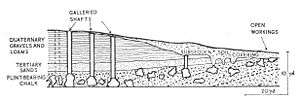Neolithic flint mines of Spiennes
The Neolithic flint mines of Spiennes are among the largest and earliest Neolithic flint mines which survive in north-western Europe and are located close to the Walloon village of Spiennes, southeast of Mons, Belgium.[1] The mines were active during the mid and late Neolithic (4300–2200 BC). The site and its surroundings were added to the UNESCO's list of World Heritage Sites in 2000.
Description
The list of UNESCO World Heritage Sites has included the mines since 2000 and describes them as "among the largest and earliest concentration of ancient flint mines in north-western Europe", citing the level of human technological development they demonstrate as justification for their inclusion.[2]
The mines cover some 100 hectares (250 acres) of downland near Mons in Belgium and are interesting for showing the transition between opencast and underground mining for the flint nodules. The nodules were extracted using flint picks. The stones were then knapped into rough-out shapes of axes, and finally polished to achieve the final state.
The rough-outs were exchanged over a wide area, about 150 kilometres (93 mi), and were often polished at their destination. Polishing strengthens the final product, making the axe- or adze-head last longer. The smooth surface also aids the cutting action by lowering friction with the wood. The axes were used initially for forest clearance during the Neolithic period, and for shaping wood for structural applications, such as timber for huts and canoes.
| Neolithic mines of flint of the "Camp à Caillaux" |
| Neolithic mines of the "Camp à Caillaux" |
| Archaeological excavations in the Neolithic flint mining "Camp Caillaux |
|
Other sites
The site is comparable with Grimes Graves and Cissbury in the United Kingdom, and Krzemionki in Poland, which were also sources of flint. Other hard rocks were used for making polished stone axes however. There are many locations in Britain where fine-grained igneous or metamorphic rocks were collected from screes or mined opencast, then roughed out locally before trading on to other parts of the country. Examples include the Langdale axe industry, Penmaenmawr and Tievebulliagh.
References
- Citations
- Bibliography
- C. Guillaume, Ph. Lipinski & A. Masson: Les mines de silex néolithiques de la Meuse dans le contexte européen. Musées de la Meuse, Sampigny 1987. (French)
- F. Gosselin: Un site d'exploitation du silex à Spiennes (Hainaut), au lieu-dit "Petit-Spiennes". Vie archéologique 22, 1986, 33-160. (French)
- F. Hubert: Une minière néolithique à silex au Camp-à-Cayaux de Spiennes. Archaeologia Belgica, 210, 1978. (French)
- F. Hubert: L'exploitation préhistorique du silex à Spiennes. Carnets du Patrimoine n°22. Ministère de la Région wallonne, Direction générale de l'Aménagement du Territoire, du Logement et du Patrimoine, Namur 1997. (French)
- R. Shepherd: Prehistoric Mining and Allied Industries. (Academic Press, London 1980).
- Société de recherches préhistoriques en Hainaut: Minières néolithiques à Spiennes (Petit-Spiennes). 1997 (French)
- ICOMOS evaluation
- Collet, H. (2004). "Les mines néolithiques de Spiennes : état des connaissances et perspectives de recherche" (PDF). Section 10: The Neolithic in the Near East and Europe (in French). Oxford: Archaeopress. ISBN 1-84171-653-7. Retrieved 27 July 2011.
Actes du XIVème congrès UISPP, Université de Liège, Belgique, 2 - 8 septembre 2001
- H. Collet, A. Hauzeur & J. Lech, 2008. The prehistoric flint mining complex at Spiennes (Belgium) on the occasion of its discovery 140 years ago In P. Allard, F. Bostyn, F. Giligny & J. Lech, 2008. Flint mining in Prehistoric Europe: Interpreting the archaeological records. European Association of Archaeologists, 12th Annual Meeting, Cracow, Poland, 19-24 September 2006 (BAR International Series 1891): 41-77.
- H. Collet, 2014.Les minières néolithiques de silex de Spiennes. Patrimoine mondial de l’Humanité (Carnets du patrimoine 126), Institut du Patrimoine wallon, 55 p.
External links
 Media related to Spiennes at Wikimedia Commons
Media related to Spiennes at Wikimedia Commons-
|
|---|
|
| |
|
1 Listing shared with six other countries, which includes Belgium's Maison Guiette; 2 Listing shared with France. |
|
|---|
|
- Paleoanthropological sites
- Cave paintings
- Caves containing pictograms
|
|
|
|
|
|
|
|
|
|
|
|
|


 Media related to Spiennes at Wikimedia Commons
Media related to Spiennes at Wikimedia Commons
.jpg)
.jpg)
.jpg)

